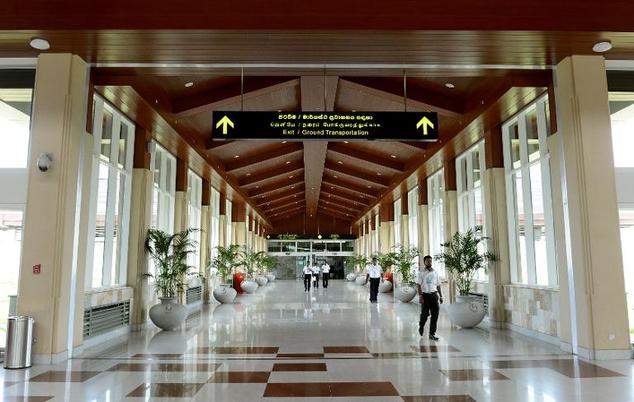(A security guard looks at the runway from within a departure area at the international airport at Hambantota ©Lakruwan Wanniarachchi (AFP/File))
(AFP) From a multi-million dollar airport ignored by airlines to a lavish cricket stadium rejected by players, Sri Lanka’s new government is mulling the future of a string of white elephants.
Former president Mahinda Rajapakse ordered the state-of-the-art facilities built in his southern home town of Hambantota in extensive efforts to turn his rural constituency into a regional business hub.
Vast revenues were channelled into the vanity projects, mostly named after the former strongman who ruled the tropical island for a decade and was determined to keep the loss-making ventures open.
But Rajapakse’s defeat at elections last month, partly due to corruption and cronyism charges, has saddled the new government with loans of close to a billion dollars and, as yet, no clear strategy to repay them.
“From an economist’s point of view, we have to write off the investments,” said Eran Wickramaratne, deputy minister of highways and investment promotion.
“We will have to repay the loans for a long time, but we can’t expect any tangible return from them,” he told AFP.
– Eerily empty –
Opened in 2013 after loans of $210 million, the Rajapakse International airport services just one airline, budget carrier flydubai.
The arrivals hall is eerily empty and the new government has ordered the terminal’s air conditioning units and decorative water fountains switched off after the carrier’s handful of daily passengers trickle through.
National carrier SriLankan Airlines, under orders by Rajapakse to land there, halted flights immediately after he was defeated at the January 8 polls by new President Maithripala Sirisena. The airline estimates savings of $18 million annually from the stoppage.
Built on a migratory route for birds, the airport has been disastrous for plane-bird collisions. And more recently it has become a highlight on a “white elephant tour” run by local tourist guides.
“The challenge for me is to energise this place,” airport chief executive Derick Karunaratne told AFP.
“Just because there is an airport, airlines don’t fly in. They want a destination and we are yet to build it,” he said.
Located some 250 kilometres (180 miles) southeast of the capital Colombo, the town of Hambantota is an arid outpost, surrounded by farm land. But Rajapakse spent lavishly on the projects anyway, ignoring feasibility studies against the move and environmental warnings about building in an area home to elephants, leopards and bears.
– Port of debt –

The $361-million Chinese-funded harbour in Hambantota is deep in debt, but it does at least see some business from neighbouring India, whose ships full of new cars dock there en route around the world.
Officials say the port, which was meant to rival long established ones in Colombo, could break even in more than a decade.
In a bid to lure business away from Colombo, Rajapakse’s government built a sparkling six-lane highway within Hambantota district and a $52 million flyover and interchange that sees little traffic. A railway line extension and another expressway linking the area to the capital are also under construction, costing millions more.
Overlooking the port is another extravagance — a $15.5 million conference centre. After hosting a side event during the 2013 Commonwealth summit, its hall has stood empty, except for the occasional wedding reception.
A short drive away sits a 300-acre (120 hectare) botanical garden that needs tonnes of water every day to keep its non-native plants alive. Villagers scratching a living nearby must get their drinking water trucked into the area which receives little rain.
“We are growing wet-zone plants which are not native to this area,” a curator told AFP during a tour of the garden opened by Rajapakse during the Commonwealth summit.
“If people know the true extent of the water waste here, there could be a riot,” said a university professor who declined to be named. “We thought this was conservation of plants from the area, but caring for plants that require a lot of water may not be sustainable.”
– What to do? –

Similarly, scarce water is lavished on a nearby cricket ground which Rajapakse ordered built for the 2011 World Cup when the venue hosted just two matches.
The country’s cricket board was forced to borrow heavily to pay for the 35,000-seat stadium where few matches have since been played, teams put off by the isolated location and the swarms of wasps that have taken up residence.
“It is difficult to figure out what to do with them (the projects),” Finance Minister Ravi Karunanayake told AFP.
“But as a first step, we are trying to sort out the loans. We want to renegotiate some of the loans which have been taken at five to seven percent. We should not be paying more than half a percentage point.”
The government, which accuses the former Rajapakse regime of hiding the truth about the economy’s health including public debt levels, says it will keep the projects open for now, rather than call in the bulldozers.
“(But) This is a terrible waste,” concluded minister Wickramaratne.
DailyMail
